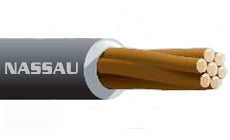Product Details
Conductor: Soft annealed tin plated copper, stranded as listed below.
Insulation: Extruded layer of irradiation cross-linked polyolefin meeting the requirements of specifications DDA 1066.
Application: This irradiated polyolefin insulated wire has outstanding flame retardant and high temperature characteristics. It combines excellent thermal stability and high electrical values to provide a superior, small diameter, electronic hook-up wire. The wire passes the difficult VW-1 fire test, has thermoset mechanical characteristics, and very low levels of corrosive content. The wires offer a cost effective alternative to the more expensive fluoropolymers such as PTFE and ETFE.
Approvals and Ratings: 125°C conductor temperature, 3000 volt. NEMA HP-5 Type LX – MIL-W-16878/16
| size | weight | rscc aerodefense part number |
Action | |||||||
| awg | mm2 | lbs/kft | kg/km | |||||||
| hp-5 type lx, 3000v | ||||||||||
| 26 | .14 | 3.9 | 5.80 | hp5lx-bdb-x | Request A Quote | |||||
| 24 | .23 | 4.7 | 6.99 | hp5lx-beb-x | Request A Quote | |||||
| 22 | .35 | 5.9 | 8.78 | hp5lx-bfb-x | Request A Quote | |||||
| 20 | .62 | 7.4 | 11.0 | hp5lx-bge-x | Request A Quote | |||||
| 18 | .96 | 10.0 | 14.9 | hp5lx-bhe-x | Request A Quote | |||||
| 16 | 1.23 | 14.0 | 21 | hp5lx-bje-x | Request A Quote | |||||
| 14 | 1.94 | 19.4 | 29 | hp5lx-bke-x | Request A Quote | |||||
| 12 | 3.08 | 28.2 | 42 | hp5lx-ble-x | Request A Quote | |||||
| 10 | 4.74 | 38.7 | 57 | hp5lx-bmg-x | Request A Quote | |||||
| 8 | 8.61 | 70.1 | 104 | hp5lx-bnl-x | Request A Quote | |||||
| 6 | 13.6 | 107 | 159 | hp5lx-bpl-x | Request A Quote | |||||
| 4 | 22.0 | 166 | 247 | hp5lx-brl-x | Request A Quote | |||||
| 2 | 34.0 | 256 | 380 | hp5lx-bsp-x | Request A Quote | |||||
| 1 | 41.0 | 314 | 467 | hp5lx-btr-x | Request A Quote | |||||
| 1/0 | 53.0 | 399 | 593 | hp5lx-bus-x | Request A Quote | |||||
| 2/0 | 67.0 | 498 | 741 | hp5lx-bwt-x | Request A Quote | |||||
| 3/0 | 85.0 | 628 | 934 | hp5lx-byv-x | Request A Quote | |||||
| 4/0 | 107 | 785 | 1168 | hp5lx-bzw-x | Request A Quote | |||||

